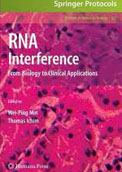RNA interference from Biology to clinical applications

RNA interference from Biology to clinical applications |
 |
Series: Springer Protocols -
Methods in Molecular Biology, Volume 623, 2010
Humana press, Totowa, NJ (USA)
Pages: 450; €114.35
ISBN: 978-1-60761-587-3
European Journal of Histochemistry 2010; 54
CarloAlberto Redi- University of Pavia - Email: carloalberto.redi@unipv.it
I strongly advice the readers to go to the Nobel foundation web site and read the Nobel lectures by Andrew Z. Fire and Craig C. Mello, the two 2006 Nobel laureates "for their discovery of RNA interference - gene silencing by double-stranded RNA" (http://nobelprize.org/ nobel_prizes/medicine/laureates/2006/).
Well, it is impressive how both the Nobel laureates clearly anticipate the immense possibility the phenomenon they discovered is giving to Biology and its applications. That is to say, they clearly visioned the great chance to both advance our theoretical understanding of gene expression regulation (i.e., how the gene networks and circuiteries are finely tuned by RNA interference, and its critical role in ontogeny) and make use in biotechnological applications of this formidable tool, notably in translational medicine. Here we go to the present volume, 450 pages divided in three sections: - physiology of RNA interference; - RNA interference in the laboratory and small interfering RNA delivery; - clinical implementation. Each section is covering all aspects entailed by the specific topic: even considering the bioinformatic approaches to RNA interference mediated by short interfering RNA (chapter six) or the computational design, considering alternative splicing, of short interfering RNA (chapter five). Quite interesting approaches, in such a fast developing field, are presented to deliver short interfering RNA molecules, from hydrodynamic protocols (chapter twelve) to the nonviral systems for gene silencing in neurodegenerative diseases (chapter fourteen). As for the clinical application, the “direct application of short interfering RNA for in vivo pain research” (chapter twenty-five) is a paradigmatic presentation of the novel strategies RNA interference is opening to both research and therapeutic application. Here it is highlighted a nonpharmacological therapeutic approach for the treatment of chronic pain, something considered by health agencies the burden of the twenty-first century. We still lack a full understanding of the nociceptive pain and still rely nearly completely to opiods for its treatment (and thus to costly personalized pharmacogenetic approach that in some countries is still a dream). A great research effort is need to find out which short interfering RNA protocol is suitable to control pain.
RNA interference is promising so much to human kind but a moltitude of researchers have to be involved in this fascinating field if we want to reach in short time at least some of the envisaged goals: the reading of this book is the right viaticum to nourish the mind of young and differently-young colleagues!
CarloAlberto Redi
University of Pavia, Italy
[TOP]